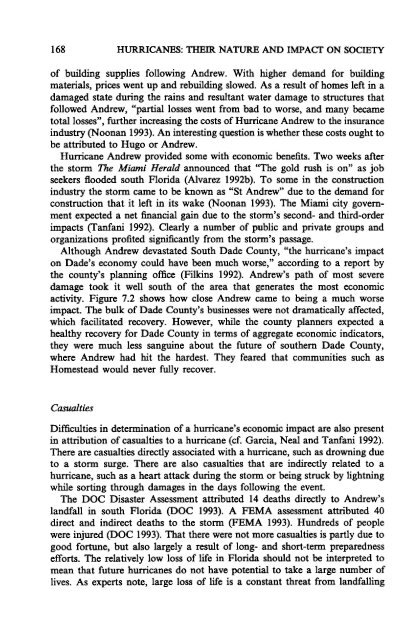Hurricanes: Their Nature and Impacts on Society - Climate Science ...
Hurricanes: Their Nature and Impacts on Society - Climate Science ...
Hurricanes: Their Nature and Impacts on Society - Climate Science ...
You also want an ePaper? Increase the reach of your titles
YUMPU automatically turns print PDFs into web optimized ePapers that Google loves.
168 HURRICANES: THEIR NATURE AND IMPACf ON SOCIETY<br />
of building supplies following Andrew. With higher dem<str<strong>on</strong>g>and</str<strong>on</strong>g> for building<br />
materials, prices went up <str<strong>on</strong>g>and</str<strong>on</strong>g> rebuilding slowed. As a result of homes left in a<br />
damaged state during the rains <str<strong>on</strong>g>and</str<strong>on</strong>g> resultant water damage to structures that<br />
followed Andrew, "partial losses went from bad to worse, <str<strong>on</strong>g>and</str<strong>on</strong>g> many became<br />
total losses", further increasing the costs of Hurricane Andrew to the insurance<br />
industry (No<strong>on</strong>an 1993). An interesting questi<strong>on</strong> is whether these costs ought to<br />
be attributed to Hugo or Andrew.<br />
Hurricane Andrew provided some with ec<strong>on</strong>omic benefits. Two weeks after<br />
the storm The Miami Herald announced that "The gold rush is <strong>on</strong>" as job<br />
seekers flooded south Florida (Alvarez 1 992b). To some in the c<strong>on</strong>structi<strong>on</strong><br />
industry the storm came to be known as 'CSt Andrew" due to the dem<str<strong>on</strong>g>and</str<strong>on</strong>g> for<br />
c<strong>on</strong>structi<strong>on</strong> that it left in its wake (No<strong>on</strong>an 1993). The Miami city government<br />
expected a net financial gain due to the storm's sec<strong>on</strong>d- <str<strong>on</strong>g>and</str<strong>on</strong>g> third-order<br />
impacts (fanfani 1992). Clearly a number of public <str<strong>on</strong>g>and</str<strong>on</strong>g> private groups <str<strong>on</strong>g>and</str<strong>on</strong>g><br />
organizati<strong>on</strong>s profited significantly from the storm's passage.<br />
Although Andrew devastated South Dade County, "the hurricane's impact<br />
<strong>on</strong> Dade's ec<strong>on</strong>omy could have been much worse," according to a report by<br />
the county's planning office (Filkins 1992). Andrew's path of most severe<br />
damage took it well south of the area that generates the most ec<strong>on</strong>omic<br />
activity. Figure 7.2 shows how close Andrew came to being a much worse<br />
impact. The bulk of Dade County's businesses were not dramatically affected,<br />
which facilitated recovery. However, while the county planners expected a<br />
healthy recovery for Dade County in terms of aggregate ec<strong>on</strong>omic indicators,<br />
they were much less sanguine about the future of southern Dade County,<br />
where Andrew had hit the hardest. They feared that communities such as<br />
Homestead would never fully recover.<br />
Casualties<br />
Difficulties in determinati<strong>on</strong> of a hurricane's ec<strong>on</strong>omic impact are also present<br />
in attributi<strong>on</strong> of casualties to a hurricane (cf. Garcia, Neal <str<strong>on</strong>g>and</str<strong>on</strong>g> Tanfani 1992).<br />
There are casualties directly associated with a hurricane, such as drowning due<br />
to a storm surge. There are also casualties that are indirectly related to a<br />
hurricane, such as a heart attack during the storm or being struck by lightning<br />
while sorting through damages in the days following the event.<br />
The DOC Disaster Assessment attributed 14 deaths directly to Andrew's<br />
l<str<strong>on</strong>g>and</str<strong>on</strong>g>fall in south Florida (DOC 1993). A FEMA assessment attributed 40<br />
direct <str<strong>on</strong>g>and</str<strong>on</strong>g> indirect deaths to the storm (FEMA 1993). Hundreds of people<br />
were injured (DOC 1993). That there were not more casualties is partly due to<br />
good fortune, but also largely a result of l<strong>on</strong>g- <str<strong>on</strong>g>and</str<strong>on</strong>g> short-term preparedness<br />
efforts. The relatively low loss of life in Florida should not be interpreted to<br />
mean that future hurricanes do not have potential to take a large number of<br />
lives. As experts note, large loss of life is a c<strong>on</strong>stant threat from l<str<strong>on</strong>g>and</str<strong>on</strong>g>falling














